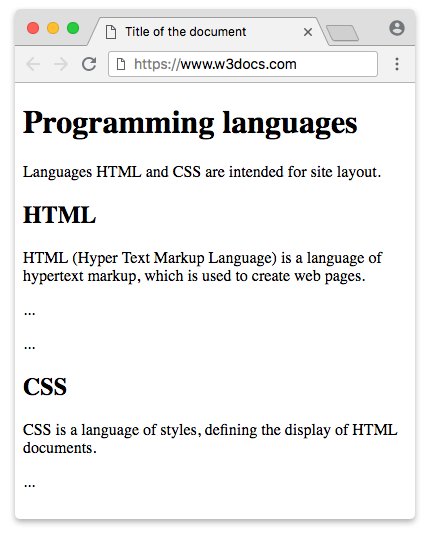The <main> tag is a new block-level element in the HTML5 specification. The tag specifies the dominant content of the document's <body>. The content of the <main> tag must be unique and do not duplicate blocks of the same type that are repeated in other documents, such as the header of a site, header, footer, menu, search, copyright information, etc.
The <main> element mustn’t be placed in the <article>, <aside>, <footer>, <header> or <nav> tags. A document must not have more than one <main> tag which does not have a specified hidden attribute.
This element doesn’t affect the DOM’s concept of the page’s structure, unlike such elements as <body>, <h2>, and others.
Assistive technology can use landmarks for quickly identifying and navigating to the document’s large sections. It is recommended to use the <main> element and not to declare role="main".
Assistive technology user can skip large sections of repeated content using “skipnav” technique. This allows the user to easily access a page’s main content. If you add an id attribute to the <main> element, it will be the target of a skip navigation link.
Syntax
The <main> tag comes in pairs. The content is written between the opening (<main>) and closing (</main>) tags.
Example of the HTML <main> tag:
<!DOCTYPE html>
<html>
<head>
<title>Title of the document</title>
</head>
<body>
<main>
<h1>Programming languages</h1>
<p>
Languages HTML and CSS are intended for site layout.
</p>
<article>
<h2>HTML</h2>
<p>
HTML (Hyper Text Markup Language) is a language of hypertext markup, which is used to create web pages.
</p>
<p>... </p>
<p>... </p>
</article>
<article>
<h2>CSS</h2>
<p>
CSS is a language of styles, defining the display of HTML documents.
</p>
<p>... </p>
</article>
</main>
</body>
</html>Result

Attributes
The <main>tag supports the Global Attributes and the Event Attributes.
How to style <main> tag?
Common properties to alter the visual weight/emphasis/size of text in <main> tag:
- CSS font-style property sets the style of the font. normal | italic | oblique | initial | inherit.
- CSS font-family property specifies a prioritized list of one or more font family names and/or generic family names for the selected element.
- CSS font-size property sets the size of the font.
- CSS font-weight property defines whether the font should be bold or thick.
- CSS text-transform property controls text case and capitalization.
- CSS text-decoration property specifies the decoration added to text, and is a shorthand property for text-decoration-line, text-decoration-color, text-decoration-style.
Coloring text in <main> tag:
- CSS color property describes the color of the text content and text decorations.
- CSS background-color property sets the background color of an element.
Text layout styles for <main> tag:
- CSS text-indent property specifies the indentation of the first line in a text block.
- CSS text-overflow property specifies how overflowed content that is not displayed should be signalled to the user.
- CSS white-space property specifies how white-space inside an element is handled.
- CSS word-break property specifies where the lines should be broken.
Other properties worth looking at for <main> tag:
- CSS text-shadow property adds shadow to text.
- CSS text-align-last property sets the alignment of the last line of the text.
- CSS line-height property specifies the height of a line.
- CSS letter-spacing property defines the spaces between letters/characters in a text.
- CSS word-spacing property sets the spacing between words.
Browser support
|
|
|
|
|
|---|---|---|---|
| 6+ | 4+ | 5+ | 11.1+ |
Practice Your Knowledge
Quiz Time: Test Your Skills!
Ready to challenge what you've learned? Dive into our interactive quizzes for a deeper understanding and a fun way to reinforce your knowledge.